Employability Skills 1 Report: National Trust, Performance & Solutions
VerifiedAdded on 2023/01/13
|16
|4163
|94
Report
AI Summary
This report analyzes employability skills within the context of the National Trust, focusing on the role of a Visitor Welcome Manager. It begins by outlining the manager's responsibilities and performance objectives, including measurable goals and time-bound targets for enhancing visitor experiences and membership numbers. The report then evaluates the manager's effectiveness against these objectives, identifying communication challenges and recommending self-improvement strategies, such as communication training. It explores motivational techniques, including Herzberg's Two-Factor Theory and Maslow's Hierarchy of Needs, to improve team performance. Furthermore, the report addresses work-based problems within the organization, such as team ineffectiveness, and proposes solutions involving problem analysis, research, and the generation of solutions. It also evaluates communication channels, both formal and informal, verbal and non-verbal, used within the National Trust to facilitate effective information transfer and address staff concerns. The report concludes with a critical reflection on the manager's work and the justification of valid conclusions regarding performance and areas for improvement.
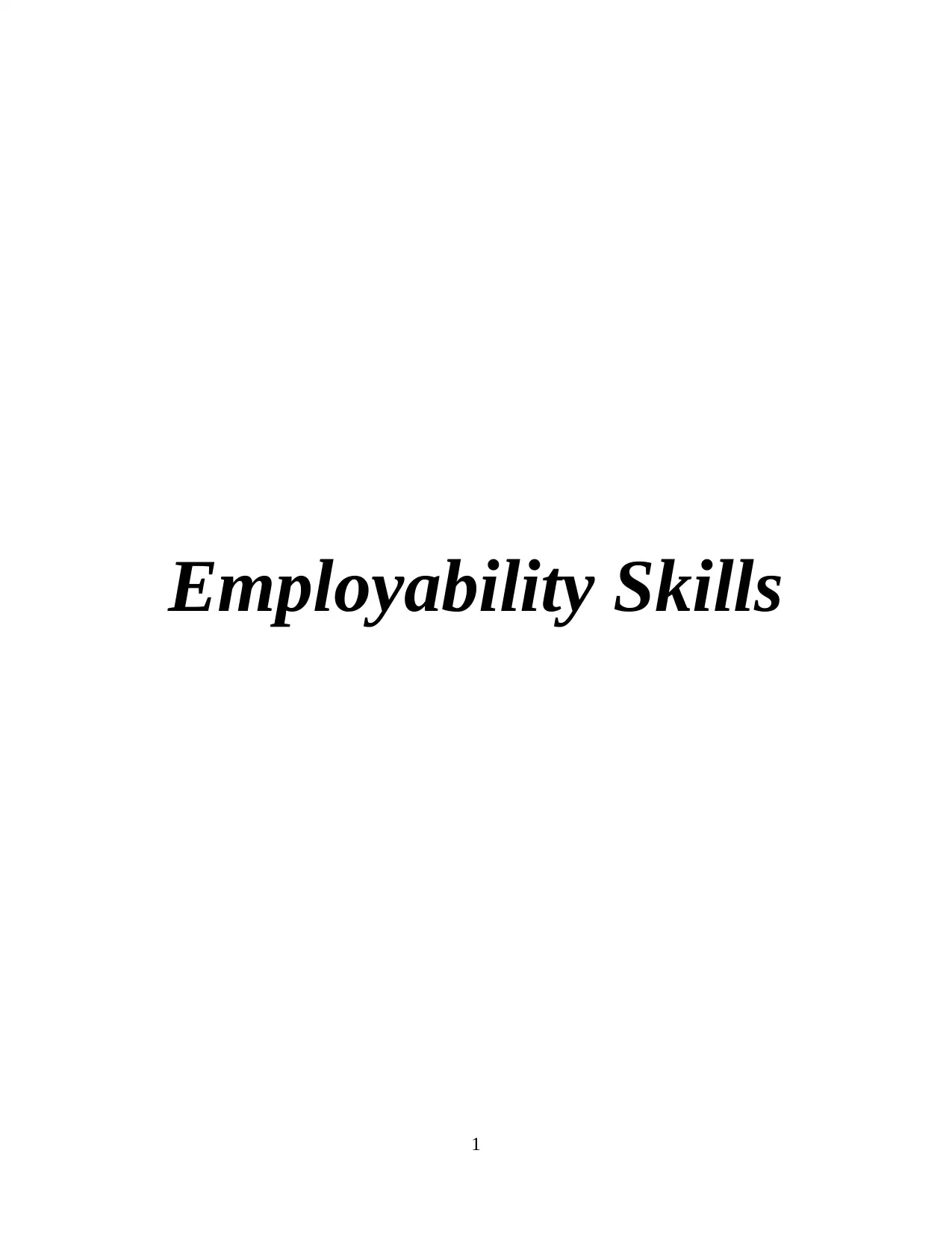
Employability Skills
1
1
Paraphrase This Document
Need a fresh take? Get an instant paraphrase of this document with our AI Paraphraser
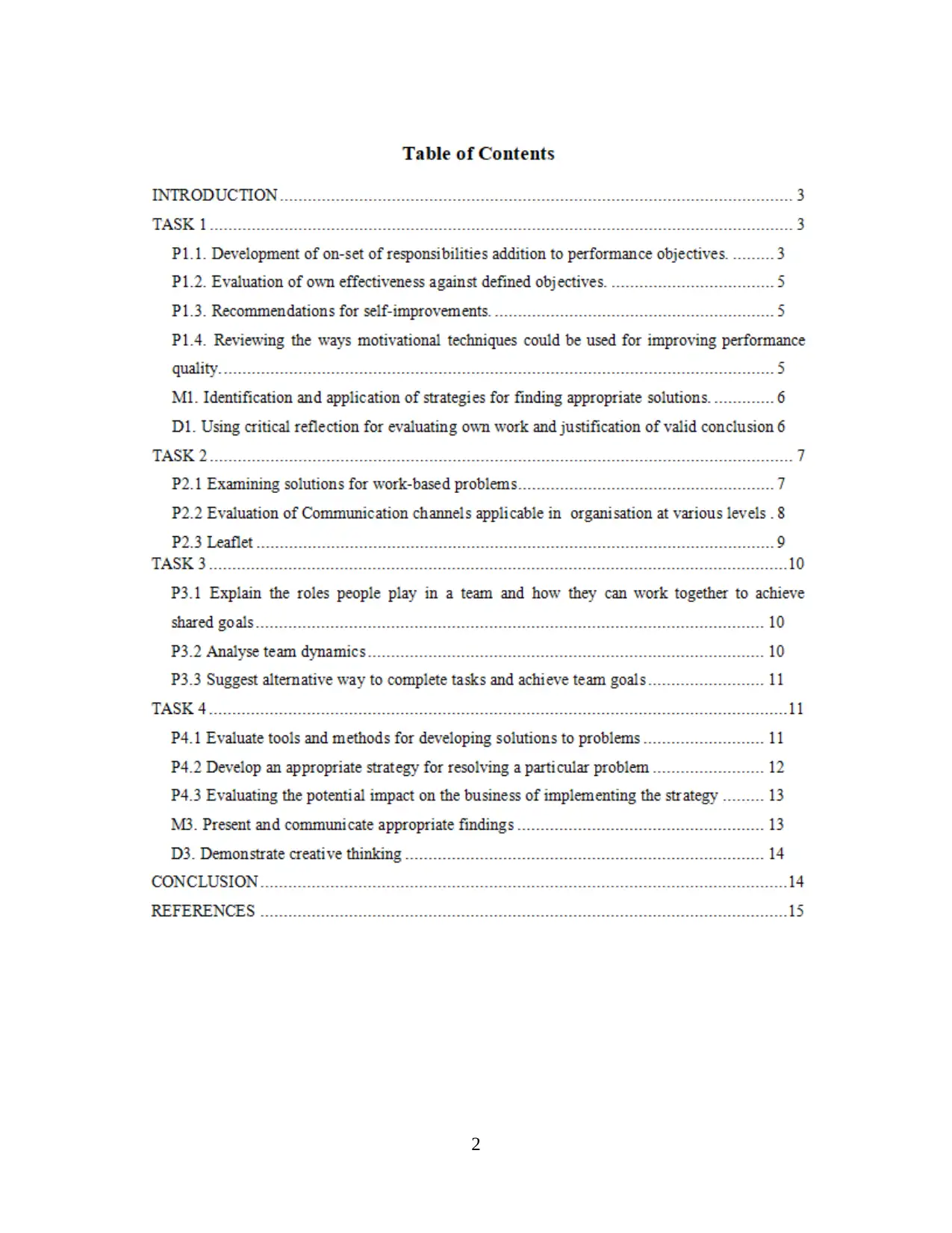
2
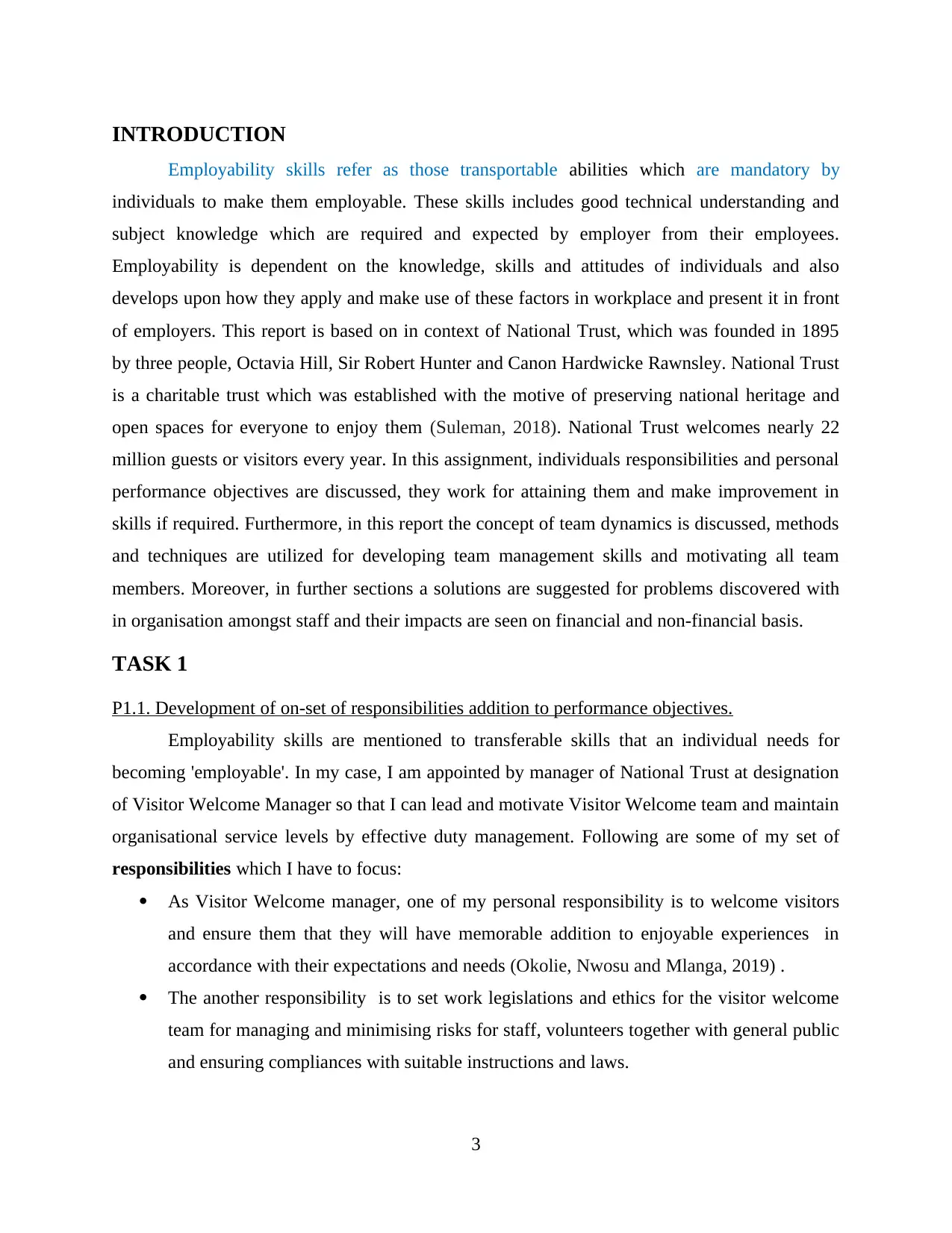
INTRODUCTION
Employability skills refer as those transportable abilities which are mandatory by
individuals to make them employable. These skills includes good technical understanding and
subject knowledge which are required and expected by employer from their employees.
Employability is dependent on the knowledge, skills and attitudes of individuals and also
develops upon how they apply and make use of these factors in workplace and present it in front
of employers. This report is based on in context of National Trust, which was founded in 1895
by three people, Octavia Hill, Sir Robert Hunter and Canon Hardwicke Rawnsley. National Trust
is a charitable trust which was established with the motive of preserving national heritage and
open spaces for everyone to enjoy them (Suleman, 2018). National Trust welcomes nearly 22
million guests or visitors every year. In this assignment, individuals responsibilities and personal
performance objectives are discussed, they work for attaining them and make improvement in
skills if required. Furthermore, in this report the concept of team dynamics is discussed, methods
and techniques are utilized for developing team management skills and motivating all team
members. Moreover, in further sections a solutions are suggested for problems discovered with
in organisation amongst staff and their impacts are seen on financial and non-financial basis.
TASK 1
P1.1. Development of on-set of responsibilities addition to performance objectives.
Employability skills are mentioned to transferable skills that an individual needs for
becoming 'employable'. In my case, I am appointed by manager of National Trust at designation
of Visitor Welcome Manager so that I can lead and motivate Visitor Welcome team and maintain
organisational service levels by effective duty management. Following are some of my set of
responsibilities which I have to focus:
As Visitor Welcome manager, one of my personal responsibility is to welcome visitors
and ensure them that they will have memorable addition to enjoyable experiences in
accordance with their expectations and needs (Okolie, Nwosu and Mlanga, 2019) .
The another responsibility is to set work legislations and ethics for the visitor welcome
team for managing and minimising risks for staff, volunteers together with general public
and ensuring compliances with suitable instructions and laws.
3
Employability skills refer as those transportable abilities which are mandatory by
individuals to make them employable. These skills includes good technical understanding and
subject knowledge which are required and expected by employer from their employees.
Employability is dependent on the knowledge, skills and attitudes of individuals and also
develops upon how they apply and make use of these factors in workplace and present it in front
of employers. This report is based on in context of National Trust, which was founded in 1895
by three people, Octavia Hill, Sir Robert Hunter and Canon Hardwicke Rawnsley. National Trust
is a charitable trust which was established with the motive of preserving national heritage and
open spaces for everyone to enjoy them (Suleman, 2018). National Trust welcomes nearly 22
million guests or visitors every year. In this assignment, individuals responsibilities and personal
performance objectives are discussed, they work for attaining them and make improvement in
skills if required. Furthermore, in this report the concept of team dynamics is discussed, methods
and techniques are utilized for developing team management skills and motivating all team
members. Moreover, in further sections a solutions are suggested for problems discovered with
in organisation amongst staff and their impacts are seen on financial and non-financial basis.
TASK 1
P1.1. Development of on-set of responsibilities addition to performance objectives.
Employability skills are mentioned to transferable skills that an individual needs for
becoming 'employable'. In my case, I am appointed by manager of National Trust at designation
of Visitor Welcome Manager so that I can lead and motivate Visitor Welcome team and maintain
organisational service levels by effective duty management. Following are some of my set of
responsibilities which I have to focus:
As Visitor Welcome manager, one of my personal responsibility is to welcome visitors
and ensure them that they will have memorable addition to enjoyable experiences in
accordance with their expectations and needs (Okolie, Nwosu and Mlanga, 2019) .
The another responsibility is to set work legislations and ethics for the visitor welcome
team for managing and minimising risks for staff, volunteers together with general public
and ensuring compliances with suitable instructions and laws.
3
⊘ This is a preview!⊘
Do you want full access?
Subscribe today to unlock all pages.

Trusted by 1+ million students worldwide
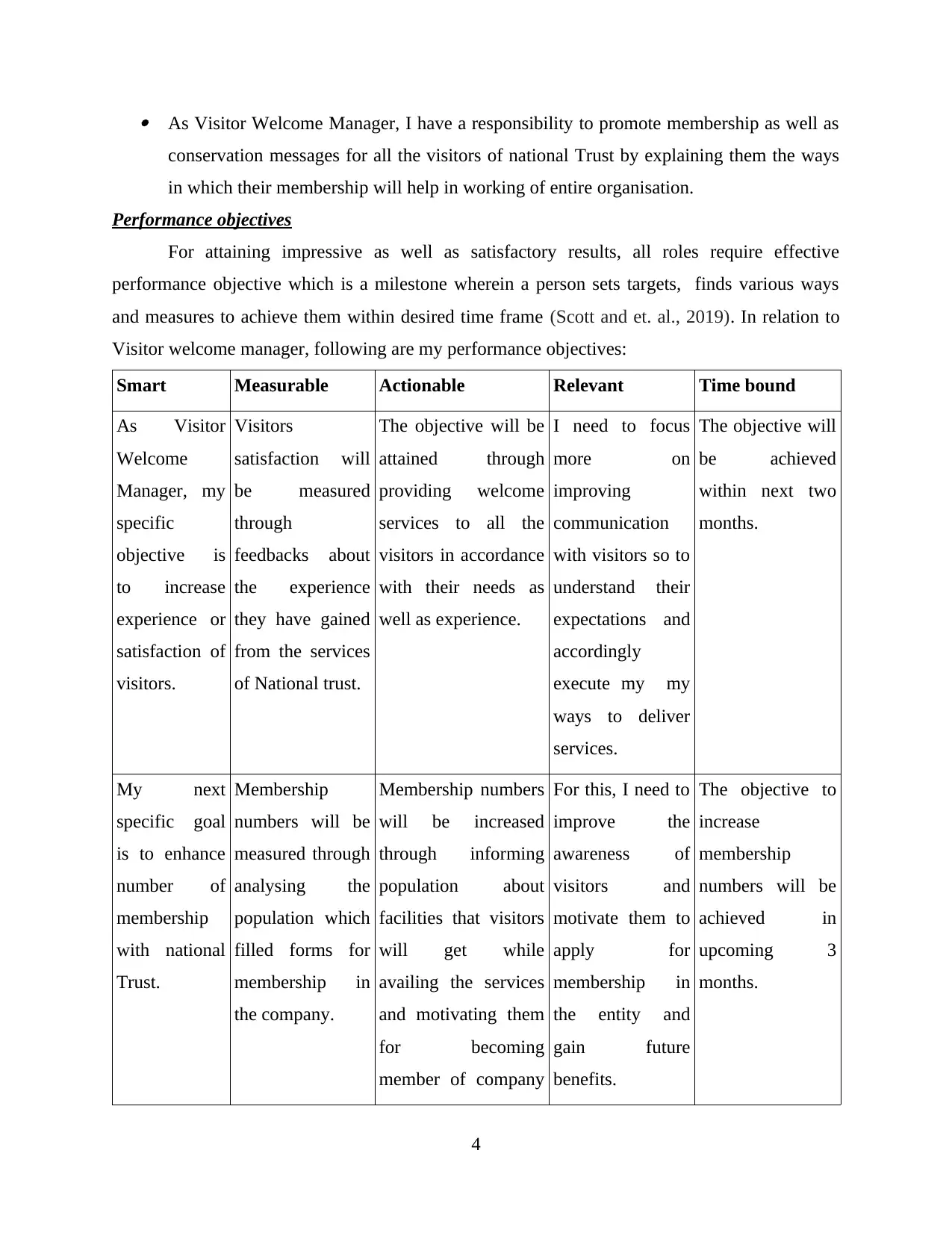
As Visitor Welcome Manager, I have a responsibility to promote membership as well as
conservation messages for all the visitors of national Trust by explaining them the ways
in which their membership will help in working of entire organisation.
Performance objectives
For attaining impressive as well as satisfactory results, all roles require effective
performance objective which is a milestone wherein a person sets targets, finds various ways
and measures to achieve them within desired time frame (Scott and et. al., 2019). In relation to
Visitor welcome manager, following are my performance objectives:
Smart Measurable Actionable Relevant Time bound
As Visitor
Welcome
Manager, my
specific
objective is
to increase
experience or
satisfaction of
visitors.
Visitors
satisfaction will
be measured
through
feedbacks about
the experience
they have gained
from the services
of National trust.
The objective will be
attained through
providing welcome
services to all the
visitors in accordance
with their needs as
well as experience.
I need to focus
more on
improving
communication
with visitors so to
understand their
expectations and
accordingly
execute my my
ways to deliver
services.
The objective will
be achieved
within next two
months.
My next
specific goal
is to enhance
number of
membership
with national
Trust.
Membership
numbers will be
measured through
analysing the
population which
filled forms for
membership in
the company.
Membership numbers
will be increased
through informing
population about
facilities that visitors
will get while
availing the services
and motivating them
for becoming
member of company
For this, I need to
improve the
awareness of
visitors and
motivate them to
apply for
membership in
the entity and
gain future
benefits.
The objective to
increase
membership
numbers will be
achieved in
upcoming 3
months.
4
conservation messages for all the visitors of national Trust by explaining them the ways
in which their membership will help in working of entire organisation.
Performance objectives
For attaining impressive as well as satisfactory results, all roles require effective
performance objective which is a milestone wherein a person sets targets, finds various ways
and measures to achieve them within desired time frame (Scott and et. al., 2019). In relation to
Visitor welcome manager, following are my performance objectives:
Smart Measurable Actionable Relevant Time bound
As Visitor
Welcome
Manager, my
specific
objective is
to increase
experience or
satisfaction of
visitors.
Visitors
satisfaction will
be measured
through
feedbacks about
the experience
they have gained
from the services
of National trust.
The objective will be
attained through
providing welcome
services to all the
visitors in accordance
with their needs as
well as experience.
I need to focus
more on
improving
communication
with visitors so to
understand their
expectations and
accordingly
execute my my
ways to deliver
services.
The objective will
be achieved
within next two
months.
My next
specific goal
is to enhance
number of
membership
with national
Trust.
Membership
numbers will be
measured through
analysing the
population which
filled forms for
membership in
the company.
Membership numbers
will be increased
through informing
population about
facilities that visitors
will get while
availing the services
and motivating them
for becoming
member of company
For this, I need to
improve the
awareness of
visitors and
motivate them to
apply for
membership in
the entity and
gain future
benefits.
The objective to
increase
membership
numbers will be
achieved in
upcoming 3
months.
4
Paraphrase This Document
Need a fresh take? Get an instant paraphrase of this document with our AI Paraphraser
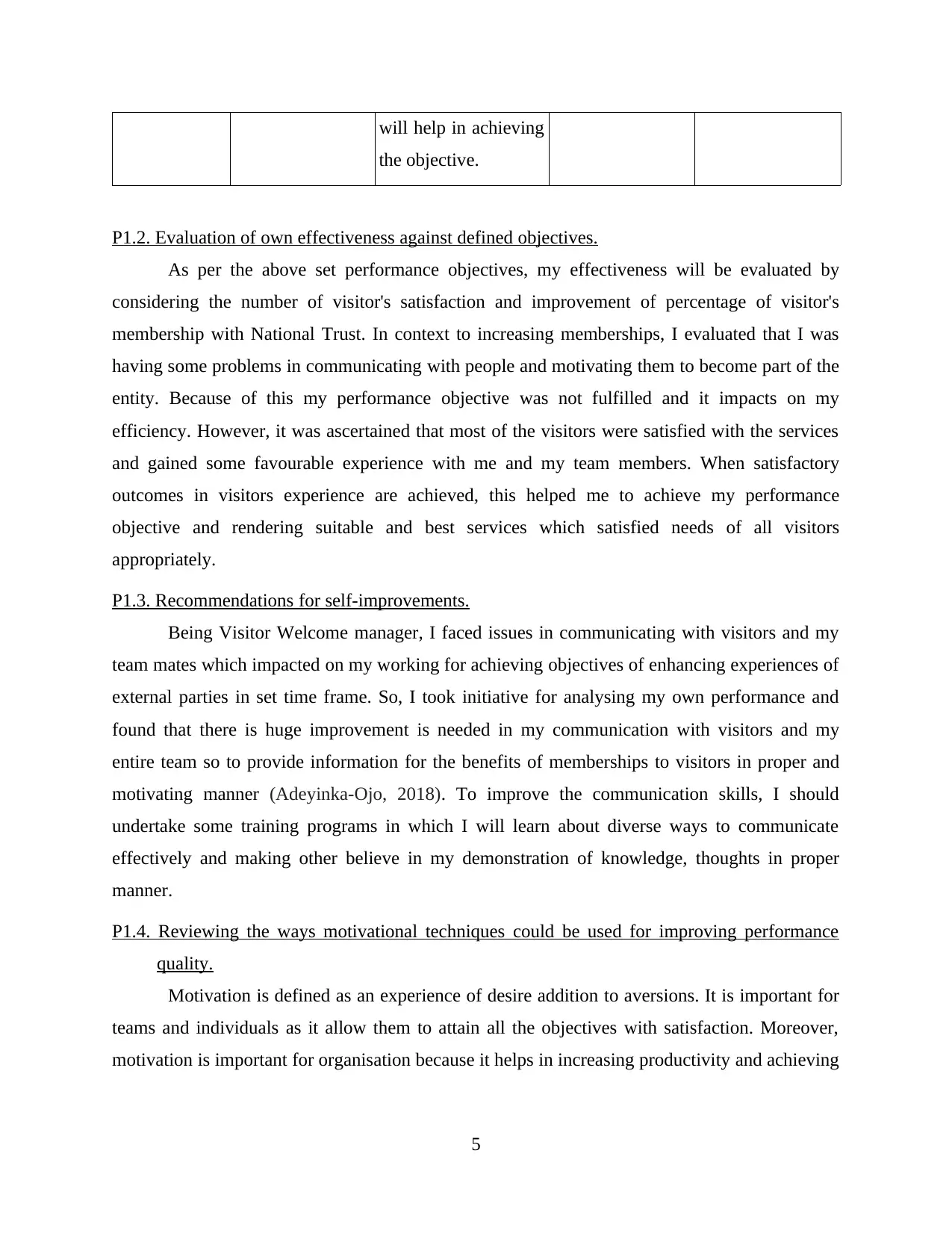
will help in achieving
the objective.
P1.2. Evaluation of own effectiveness against defined objectives.
As per the above set performance objectives, my effectiveness will be evaluated by
considering the number of visitor's satisfaction and improvement of percentage of visitor's
membership with National Trust. In context to increasing memberships, I evaluated that I was
having some problems in communicating with people and motivating them to become part of the
entity. Because of this my performance objective was not fulfilled and it impacts on my
efficiency. However, it was ascertained that most of the visitors were satisfied with the services
and gained some favourable experience with me and my team members. When satisfactory
outcomes in visitors experience are achieved, this helped me to achieve my performance
objective and rendering suitable and best services which satisfied needs of all visitors
appropriately.
P1.3. Recommendations for self-improvements.
Being Visitor Welcome manager, I faced issues in communicating with visitors and my
team mates which impacted on my working for achieving objectives of enhancing experiences of
external parties in set time frame. So, I took initiative for analysing my own performance and
found that there is huge improvement is needed in my communication with visitors and my
entire team so to provide information for the benefits of memberships to visitors in proper and
motivating manner (Adeyinka-Ojo, 2018). To improve the communication skills, I should
undertake some training programs in which I will learn about diverse ways to communicate
effectively and making other believe in my demonstration of knowledge, thoughts in proper
manner.
P1.4. Reviewing the ways motivational techniques could be used for improving performance
quality.
Motivation is defined as an experience of desire addition to aversions. It is important for
teams and individuals as it allow them to attain all the objectives with satisfaction. Moreover,
motivation is important for organisation because it helps in increasing productivity and achieving
5
the objective.
P1.2. Evaluation of own effectiveness against defined objectives.
As per the above set performance objectives, my effectiveness will be evaluated by
considering the number of visitor's satisfaction and improvement of percentage of visitor's
membership with National Trust. In context to increasing memberships, I evaluated that I was
having some problems in communicating with people and motivating them to become part of the
entity. Because of this my performance objective was not fulfilled and it impacts on my
efficiency. However, it was ascertained that most of the visitors were satisfied with the services
and gained some favourable experience with me and my team members. When satisfactory
outcomes in visitors experience are achieved, this helped me to achieve my performance
objective and rendering suitable and best services which satisfied needs of all visitors
appropriately.
P1.3. Recommendations for self-improvements.
Being Visitor Welcome manager, I faced issues in communicating with visitors and my
team mates which impacted on my working for achieving objectives of enhancing experiences of
external parties in set time frame. So, I took initiative for analysing my own performance and
found that there is huge improvement is needed in my communication with visitors and my
entire team so to provide information for the benefits of memberships to visitors in proper and
motivating manner (Adeyinka-Ojo, 2018). To improve the communication skills, I should
undertake some training programs in which I will learn about diverse ways to communicate
effectively and making other believe in my demonstration of knowledge, thoughts in proper
manner.
P1.4. Reviewing the ways motivational techniques could be used for improving performance
quality.
Motivation is defined as an experience of desire addition to aversions. It is important for
teams and individuals as it allow them to attain all the objectives with satisfaction. Moreover,
motivation is important for organisation because it helps in increasing productivity and achieving
5
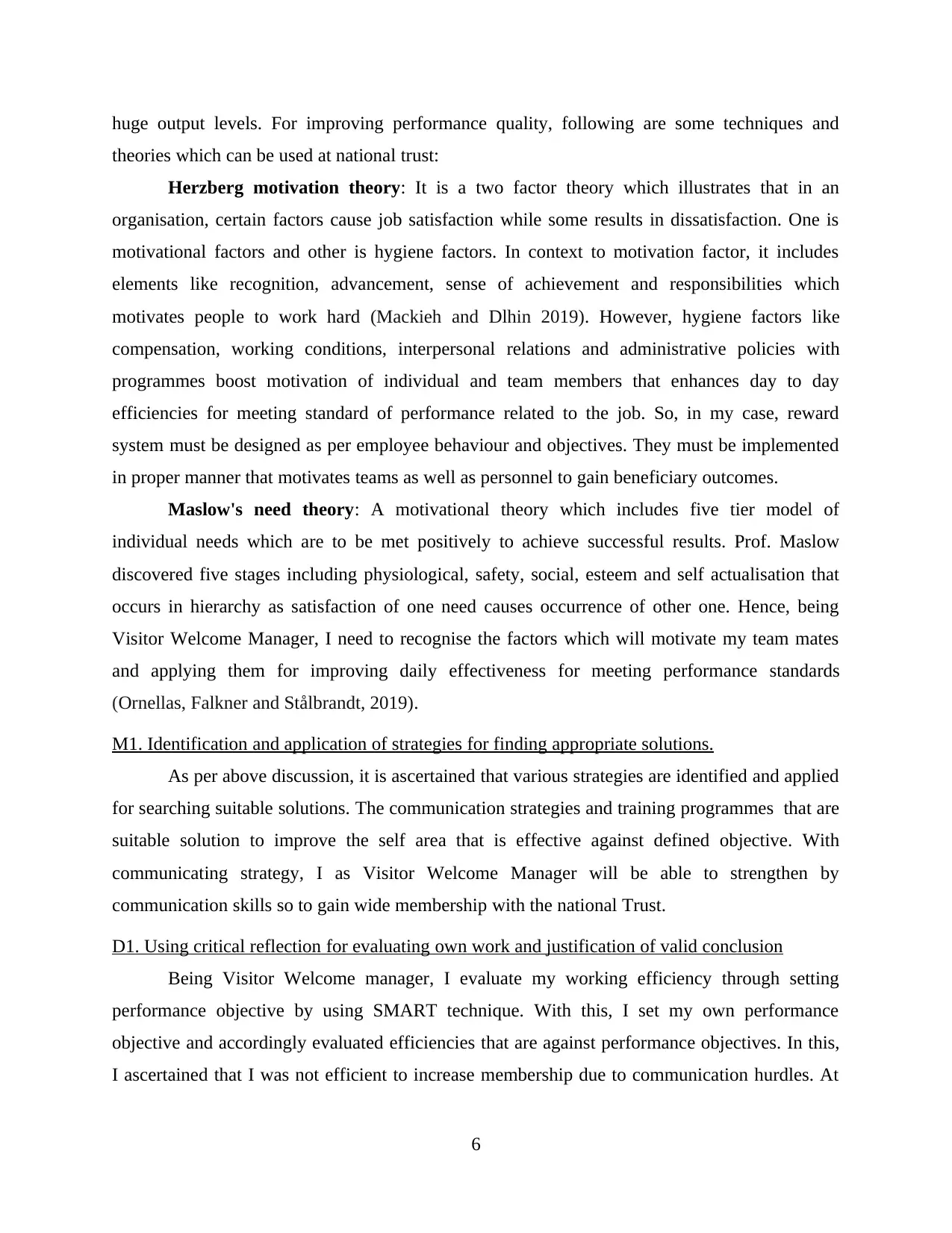
huge output levels. For improving performance quality, following are some techniques and
theories which can be used at national trust:
Herzberg motivation theory: It is a two factor theory which illustrates that in an
organisation, certain factors cause job satisfaction while some results in dissatisfaction. One is
motivational factors and other is hygiene factors. In context to motivation factor, it includes
elements like recognition, advancement, sense of achievement and responsibilities which
motivates people to work hard (Mackieh and Dlhin 2019). However, hygiene factors like
compensation, working conditions, interpersonal relations and administrative policies with
programmes boost motivation of individual and team members that enhances day to day
efficiencies for meeting standard of performance related to the job. So, in my case, reward
system must be designed as per employee behaviour and objectives. They must be implemented
in proper manner that motivates teams as well as personnel to gain beneficiary outcomes.
Maslow's need theory: A motivational theory which includes five tier model of
individual needs which are to be met positively to achieve successful results. Prof. Maslow
discovered five stages including physiological, safety, social, esteem and self actualisation that
occurs in hierarchy as satisfaction of one need causes occurrence of other one. Hence, being
Visitor Welcome Manager, I need to recognise the factors which will motivate my team mates
and applying them for improving daily effectiveness for meeting performance standards
(Ornellas, Falkner and Stålbrandt, 2019).
M1. Identification and application of strategies for finding appropriate solutions.
As per above discussion, it is ascertained that various strategies are identified and applied
for searching suitable solutions. The communication strategies and training programmes that are
suitable solution to improve the self area that is effective against defined objective. With
communicating strategy, I as Visitor Welcome Manager will be able to strengthen by
communication skills so to gain wide membership with the national Trust.
D1. Using critical reflection for evaluating own work and justification of valid conclusion
Being Visitor Welcome manager, I evaluate my working efficiency through setting
performance objective by using SMART technique. With this, I set my own performance
objective and accordingly evaluated efficiencies that are against performance objectives. In this,
I ascertained that I was not efficient to increase membership due to communication hurdles. At
6
theories which can be used at national trust:
Herzberg motivation theory: It is a two factor theory which illustrates that in an
organisation, certain factors cause job satisfaction while some results in dissatisfaction. One is
motivational factors and other is hygiene factors. In context to motivation factor, it includes
elements like recognition, advancement, sense of achievement and responsibilities which
motivates people to work hard (Mackieh and Dlhin 2019). However, hygiene factors like
compensation, working conditions, interpersonal relations and administrative policies with
programmes boost motivation of individual and team members that enhances day to day
efficiencies for meeting standard of performance related to the job. So, in my case, reward
system must be designed as per employee behaviour and objectives. They must be implemented
in proper manner that motivates teams as well as personnel to gain beneficiary outcomes.
Maslow's need theory: A motivational theory which includes five tier model of
individual needs which are to be met positively to achieve successful results. Prof. Maslow
discovered five stages including physiological, safety, social, esteem and self actualisation that
occurs in hierarchy as satisfaction of one need causes occurrence of other one. Hence, being
Visitor Welcome Manager, I need to recognise the factors which will motivate my team mates
and applying them for improving daily effectiveness for meeting performance standards
(Ornellas, Falkner and Stålbrandt, 2019).
M1. Identification and application of strategies for finding appropriate solutions.
As per above discussion, it is ascertained that various strategies are identified and applied
for searching suitable solutions. The communication strategies and training programmes that are
suitable solution to improve the self area that is effective against defined objective. With
communicating strategy, I as Visitor Welcome Manager will be able to strengthen by
communication skills so to gain wide membership with the national Trust.
D1. Using critical reflection for evaluating own work and justification of valid conclusion
Being Visitor Welcome manager, I evaluate my working efficiency through setting
performance objective by using SMART technique. With this, I set my own performance
objective and accordingly evaluated efficiencies that are against performance objectives. In this,
I ascertained that I was not efficient to increase membership due to communication hurdles. At
6
⊘ This is a preview!⊘
Do you want full access?
Subscribe today to unlock all pages.

Trusted by 1+ million students worldwide
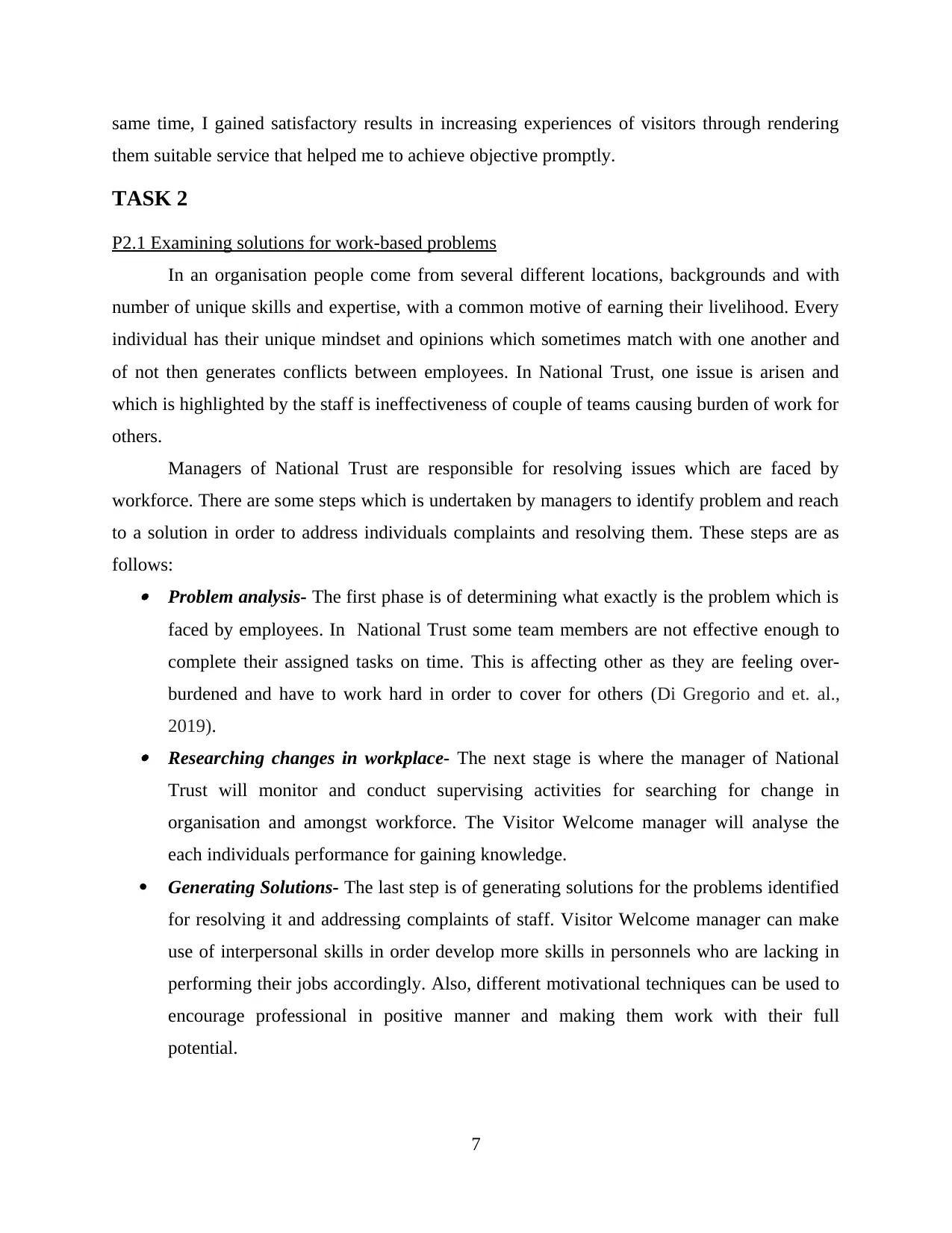
same time, I gained satisfactory results in increasing experiences of visitors through rendering
them suitable service that helped me to achieve objective promptly.
TASK 2
P2.1 Examining solutions for work-based problems
In an organisation people come from several different locations, backgrounds and with
number of unique skills and expertise, with a common motive of earning their livelihood. Every
individual has their unique mindset and opinions which sometimes match with one another and
of not then generates conflicts between employees. In National Trust, one issue is arisen and
which is highlighted by the staff is ineffectiveness of couple of teams causing burden of work for
others.
Managers of National Trust are responsible for resolving issues which are faced by
workforce. There are some steps which is undertaken by managers to identify problem and reach
to a solution in order to address individuals complaints and resolving them. These steps are as
follows: Problem analysis- The first phase is of determining what exactly is the problem which is
faced by employees. In National Trust some team members are not effective enough to
complete their assigned tasks on time. This is affecting other as they are feeling over-
burdened and have to work hard in order to cover for others (Di Gregorio and et. al.,
2019). Researching changes in workplace- The next stage is where the manager of National
Trust will monitor and conduct supervising activities for searching for change in
organisation and amongst workforce. The Visitor Welcome manager will analyse the
each individuals performance for gaining knowledge.
Generating Solutions- The last step is of generating solutions for the problems identified
for resolving it and addressing complaints of staff. Visitor Welcome manager can make
use of interpersonal skills in order develop more skills in personnels who are lacking in
performing their jobs accordingly. Also, different motivational techniques can be used to
encourage professional in positive manner and making them work with their full
potential.
7
them suitable service that helped me to achieve objective promptly.
TASK 2
P2.1 Examining solutions for work-based problems
In an organisation people come from several different locations, backgrounds and with
number of unique skills and expertise, with a common motive of earning their livelihood. Every
individual has their unique mindset and opinions which sometimes match with one another and
of not then generates conflicts between employees. In National Trust, one issue is arisen and
which is highlighted by the staff is ineffectiveness of couple of teams causing burden of work for
others.
Managers of National Trust are responsible for resolving issues which are faced by
workforce. There are some steps which is undertaken by managers to identify problem and reach
to a solution in order to address individuals complaints and resolving them. These steps are as
follows: Problem analysis- The first phase is of determining what exactly is the problem which is
faced by employees. In National Trust some team members are not effective enough to
complete their assigned tasks on time. This is affecting other as they are feeling over-
burdened and have to work hard in order to cover for others (Di Gregorio and et. al.,
2019). Researching changes in workplace- The next stage is where the manager of National
Trust will monitor and conduct supervising activities for searching for change in
organisation and amongst workforce. The Visitor Welcome manager will analyse the
each individuals performance for gaining knowledge.
Generating Solutions- The last step is of generating solutions for the problems identified
for resolving it and addressing complaints of staff. Visitor Welcome manager can make
use of interpersonal skills in order develop more skills in personnels who are lacking in
performing their jobs accordingly. Also, different motivational techniques can be used to
encourage professional in positive manner and making them work with their full
potential.
7
Paraphrase This Document
Need a fresh take? Get an instant paraphrase of this document with our AI Paraphraser
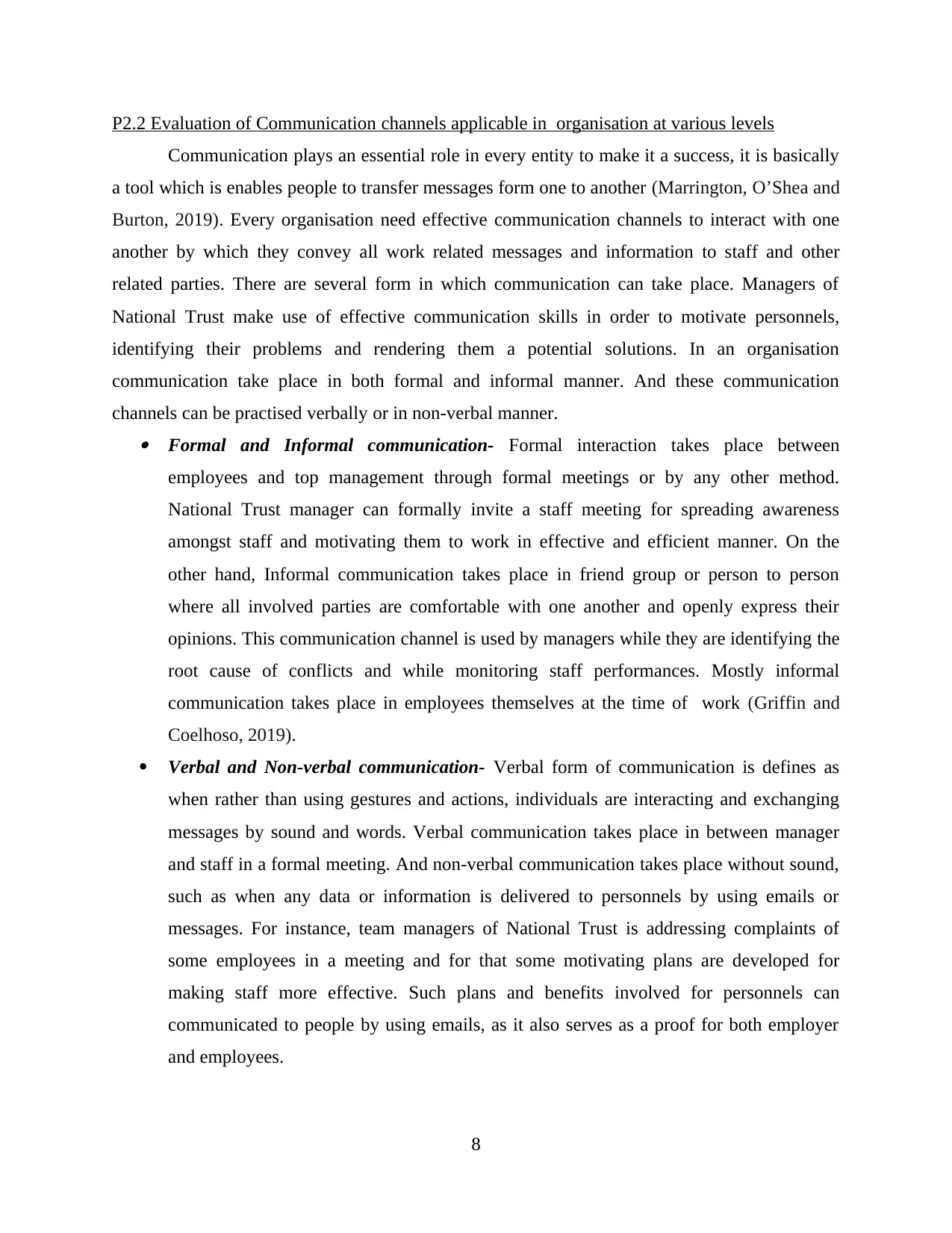
P2.2 Evaluation of Communication channels applicable in organisation at various levels
Communication plays an essential role in every entity to make it a success, it is basically
a tool which is enables people to transfer messages form one to another (Marrington, O’Shea and
Burton, 2019). Every organisation need effective communication channels to interact with one
another by which they convey all work related messages and information to staff and other
related parties. There are several form in which communication can take place. Managers of
National Trust make use of effective communication skills in order to motivate personnels,
identifying their problems and rendering them a potential solutions. In an organisation
communication take place in both formal and informal manner. And these communication
channels can be practised verbally or in non-verbal manner. Formal and Informal communication- Formal interaction takes place between
employees and top management through formal meetings or by any other method.
National Trust manager can formally invite a staff meeting for spreading awareness
amongst staff and motivating them to work in effective and efficient manner. On the
other hand, Informal communication takes place in friend group or person to person
where all involved parties are comfortable with one another and openly express their
opinions. This communication channel is used by managers while they are identifying the
root cause of conflicts and while monitoring staff performances. Mostly informal
communication takes place in employees themselves at the time of work (Griffin and
Coelhoso, 2019).
Verbal and Non-verbal communication- Verbal form of communication is defines as
when rather than using gestures and actions, individuals are interacting and exchanging
messages by sound and words. Verbal communication takes place in between manager
and staff in a formal meeting. And non-verbal communication takes place without sound,
such as when any data or information is delivered to personnels by using emails or
messages. For instance, team managers of National Trust is addressing complaints of
some employees in a meeting and for that some motivating plans are developed for
making staff more effective. Such plans and benefits involved for personnels can
communicated to people by using emails, as it also serves as a proof for both employer
and employees.
8
Communication plays an essential role in every entity to make it a success, it is basically
a tool which is enables people to transfer messages form one to another (Marrington, O’Shea and
Burton, 2019). Every organisation need effective communication channels to interact with one
another by which they convey all work related messages and information to staff and other
related parties. There are several form in which communication can take place. Managers of
National Trust make use of effective communication skills in order to motivate personnels,
identifying their problems and rendering them a potential solutions. In an organisation
communication take place in both formal and informal manner. And these communication
channels can be practised verbally or in non-verbal manner. Formal and Informal communication- Formal interaction takes place between
employees and top management through formal meetings or by any other method.
National Trust manager can formally invite a staff meeting for spreading awareness
amongst staff and motivating them to work in effective and efficient manner. On the
other hand, Informal communication takes place in friend group or person to person
where all involved parties are comfortable with one another and openly express their
opinions. This communication channel is used by managers while they are identifying the
root cause of conflicts and while monitoring staff performances. Mostly informal
communication takes place in employees themselves at the time of work (Griffin and
Coelhoso, 2019).
Verbal and Non-verbal communication- Verbal form of communication is defines as
when rather than using gestures and actions, individuals are interacting and exchanging
messages by sound and words. Verbal communication takes place in between manager
and staff in a formal meeting. And non-verbal communication takes place without sound,
such as when any data or information is delivered to personnels by using emails or
messages. For instance, team managers of National Trust is addressing complaints of
some employees in a meeting and for that some motivating plans are developed for
making staff more effective. Such plans and benefits involved for personnels can
communicated to people by using emails, as it also serves as a proof for both employer
and employees.
8
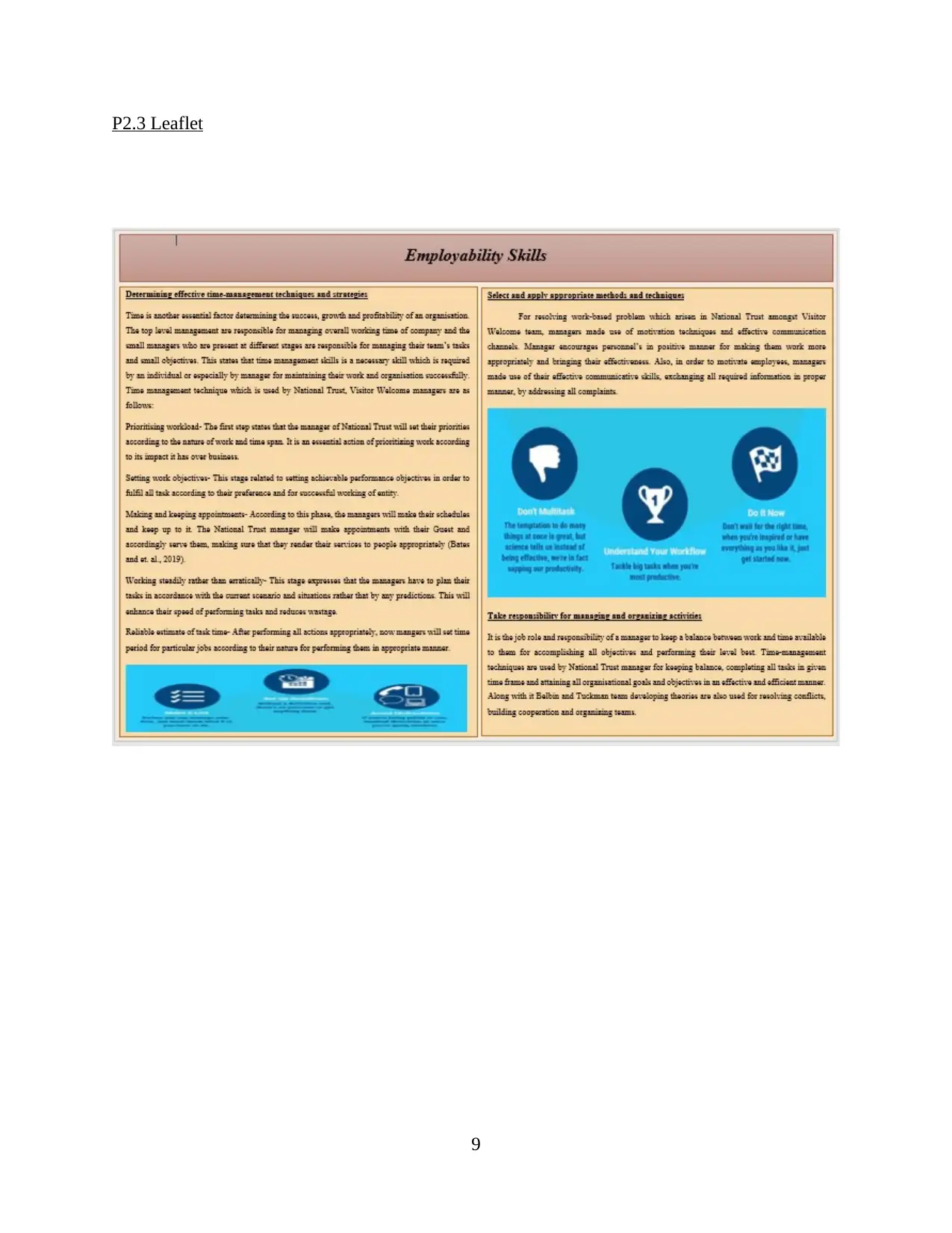
P2.3 Leaflet
9
9
⊘ This is a preview!⊘
Do you want full access?
Subscribe today to unlock all pages.

Trusted by 1+ million students worldwide
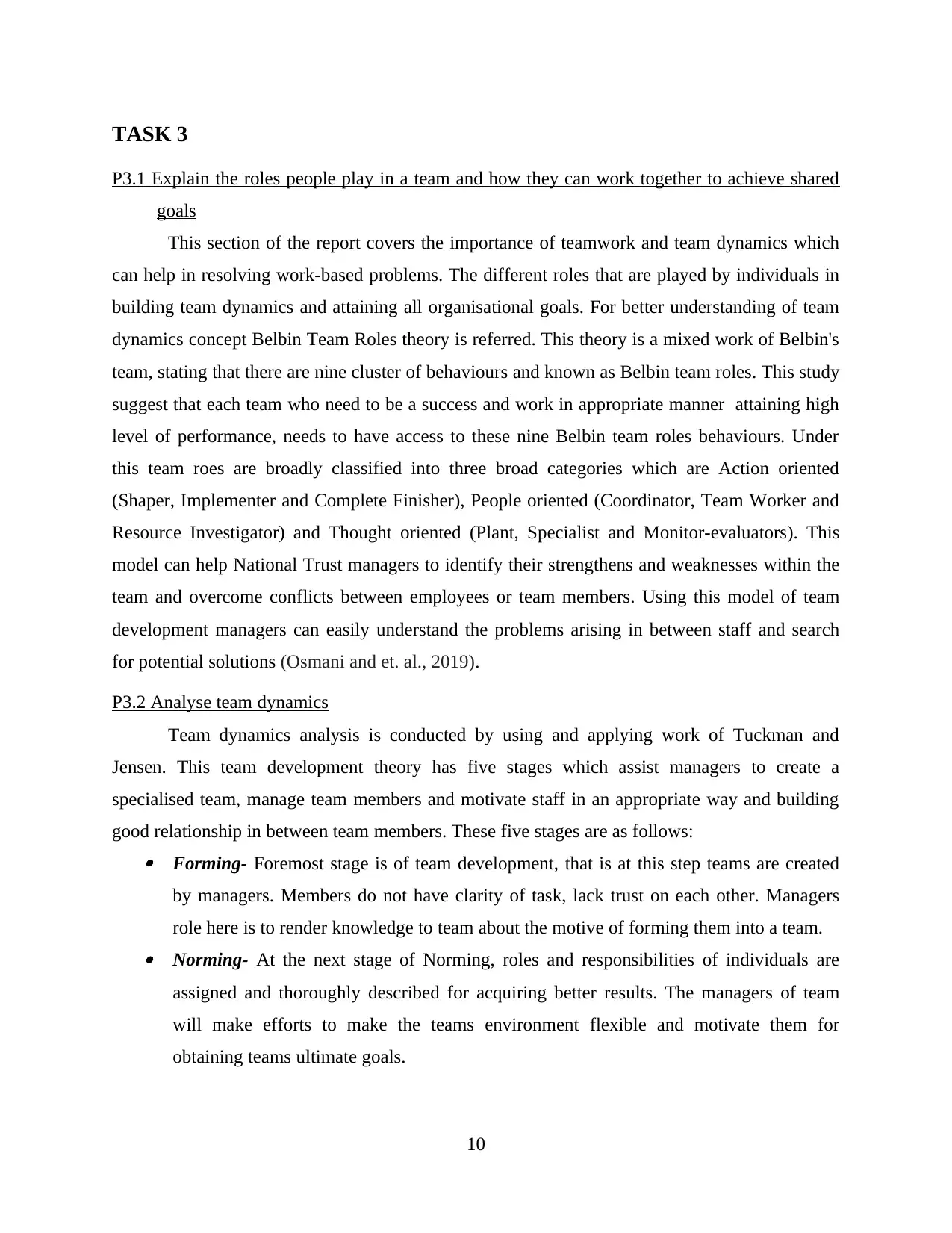
TASK 3
P3.1 Explain the roles people play in a team and how they can work together to achieve shared
goals
This section of the report covers the importance of teamwork and team dynamics which
can help in resolving work-based problems. The different roles that are played by individuals in
building team dynamics and attaining all organisational goals. For better understanding of team
dynamics concept Belbin Team Roles theory is referred. This theory is a mixed work of Belbin's
team, stating that there are nine cluster of behaviours and known as Belbin team roles. This study
suggest that each team who need to be a success and work in appropriate manner attaining high
level of performance, needs to have access to these nine Belbin team roles behaviours. Under
this team roes are broadly classified into three broad categories which are Action oriented
(Shaper, Implementer and Complete Finisher), People oriented (Coordinator, Team Worker and
Resource Investigator) and Thought oriented (Plant, Specialist and Monitor-evaluators). This
model can help National Trust managers to identify their strengthens and weaknesses within the
team and overcome conflicts between employees or team members. Using this model of team
development managers can easily understand the problems arising in between staff and search
for potential solutions (Osmani and et. al., 2019).
P3.2 Analyse team dynamics
Team dynamics analysis is conducted by using and applying work of Tuckman and
Jensen. This team development theory has five stages which assist managers to create a
specialised team, manage team members and motivate staff in an appropriate way and building
good relationship in between team members. These five stages are as follows: Forming- Foremost stage is of team development, that is at this step teams are created
by managers. Members do not have clarity of task, lack trust on each other. Managers
role here is to render knowledge to team about the motive of forming them into a team. Norming- At the next stage of Norming, roles and responsibilities of individuals are
assigned and thoroughly described for acquiring better results. The managers of team
will make efforts to make the teams environment flexible and motivate them for
obtaining teams ultimate goals.
10
P3.1 Explain the roles people play in a team and how they can work together to achieve shared
goals
This section of the report covers the importance of teamwork and team dynamics which
can help in resolving work-based problems. The different roles that are played by individuals in
building team dynamics and attaining all organisational goals. For better understanding of team
dynamics concept Belbin Team Roles theory is referred. This theory is a mixed work of Belbin's
team, stating that there are nine cluster of behaviours and known as Belbin team roles. This study
suggest that each team who need to be a success and work in appropriate manner attaining high
level of performance, needs to have access to these nine Belbin team roles behaviours. Under
this team roes are broadly classified into three broad categories which are Action oriented
(Shaper, Implementer and Complete Finisher), People oriented (Coordinator, Team Worker and
Resource Investigator) and Thought oriented (Plant, Specialist and Monitor-evaluators). This
model can help National Trust managers to identify their strengthens and weaknesses within the
team and overcome conflicts between employees or team members. Using this model of team
development managers can easily understand the problems arising in between staff and search
for potential solutions (Osmani and et. al., 2019).
P3.2 Analyse team dynamics
Team dynamics analysis is conducted by using and applying work of Tuckman and
Jensen. This team development theory has five stages which assist managers to create a
specialised team, manage team members and motivate staff in an appropriate way and building
good relationship in between team members. These five stages are as follows: Forming- Foremost stage is of team development, that is at this step teams are created
by managers. Members do not have clarity of task, lack trust on each other. Managers
role here is to render knowledge to team about the motive of forming them into a team. Norming- At the next stage of Norming, roles and responsibilities of individuals are
assigned and thoroughly described for acquiring better results. The managers of team
will make efforts to make the teams environment flexible and motivate them for
obtaining teams ultimate goals.
10
Paraphrase This Document
Need a fresh take? Get an instant paraphrase of this document with our AI Paraphraser
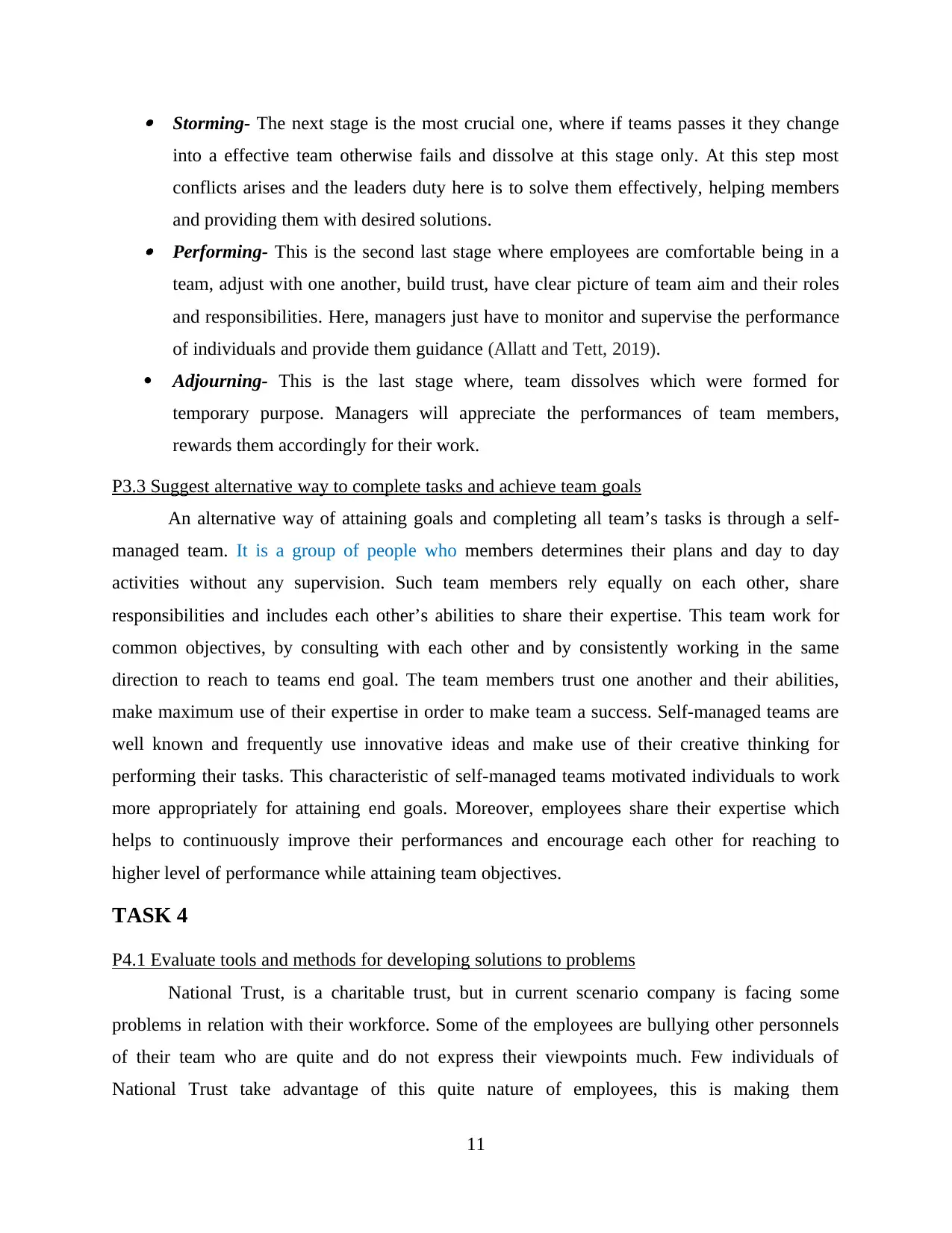
Storming- The next stage is the most crucial one, where if teams passes it they change
into a effective team otherwise fails and dissolve at this stage only. At this step most
conflicts arises and the leaders duty here is to solve them effectively, helping members
and providing them with desired solutions. Performing- This is the second last stage where employees are comfortable being in a
team, adjust with one another, build trust, have clear picture of team aim and their roles
and responsibilities. Here, managers just have to monitor and supervise the performance
of individuals and provide them guidance (Allatt and Tett, 2019).
Adjourning- This is the last stage where, team dissolves which were formed for
temporary purpose. Managers will appreciate the performances of team members,
rewards them accordingly for their work.
P3.3 Suggest alternative way to complete tasks and achieve team goals
An alternative way of attaining goals and completing all team’s tasks is through a self-
managed team. It is a group of people who members determines their plans and day to day
activities without any supervision. Such team members rely equally on each other, share
responsibilities and includes each other’s abilities to share their expertise. This team work for
common objectives, by consulting with each other and by consistently working in the same
direction to reach to teams end goal. The team members trust one another and their abilities,
make maximum use of their expertise in order to make team a success. Self-managed teams are
well known and frequently use innovative ideas and make use of their creative thinking for
performing their tasks. This characteristic of self-managed teams motivated individuals to work
more appropriately for attaining end goals. Moreover, employees share their expertise which
helps to continuously improve their performances and encourage each other for reaching to
higher level of performance while attaining team objectives.
TASK 4
P4.1 Evaluate tools and methods for developing solutions to problems
National Trust, is a charitable trust, but in current scenario company is facing some
problems in relation with their workforce. Some of the employees are bullying other personnels
of their team who are quite and do not express their viewpoints much. Few individuals of
National Trust take advantage of this quite nature of employees, this is making them
11
into a effective team otherwise fails and dissolve at this stage only. At this step most
conflicts arises and the leaders duty here is to solve them effectively, helping members
and providing them with desired solutions. Performing- This is the second last stage where employees are comfortable being in a
team, adjust with one another, build trust, have clear picture of team aim and their roles
and responsibilities. Here, managers just have to monitor and supervise the performance
of individuals and provide them guidance (Allatt and Tett, 2019).
Adjourning- This is the last stage where, team dissolves which were formed for
temporary purpose. Managers will appreciate the performances of team members,
rewards them accordingly for their work.
P3.3 Suggest alternative way to complete tasks and achieve team goals
An alternative way of attaining goals and completing all team’s tasks is through a self-
managed team. It is a group of people who members determines their plans and day to day
activities without any supervision. Such team members rely equally on each other, share
responsibilities and includes each other’s abilities to share their expertise. This team work for
common objectives, by consulting with each other and by consistently working in the same
direction to reach to teams end goal. The team members trust one another and their abilities,
make maximum use of their expertise in order to make team a success. Self-managed teams are
well known and frequently use innovative ideas and make use of their creative thinking for
performing their tasks. This characteristic of self-managed teams motivated individuals to work
more appropriately for attaining end goals. Moreover, employees share their expertise which
helps to continuously improve their performances and encourage each other for reaching to
higher level of performance while attaining team objectives.
TASK 4
P4.1 Evaluate tools and methods for developing solutions to problems
National Trust, is a charitable trust, but in current scenario company is facing some
problems in relation with their workforce. Some of the employees are bullying other personnels
of their team who are quite and do not express their viewpoints much. Few individuals of
National Trust take advantage of this quite nature of employees, this is making them
11
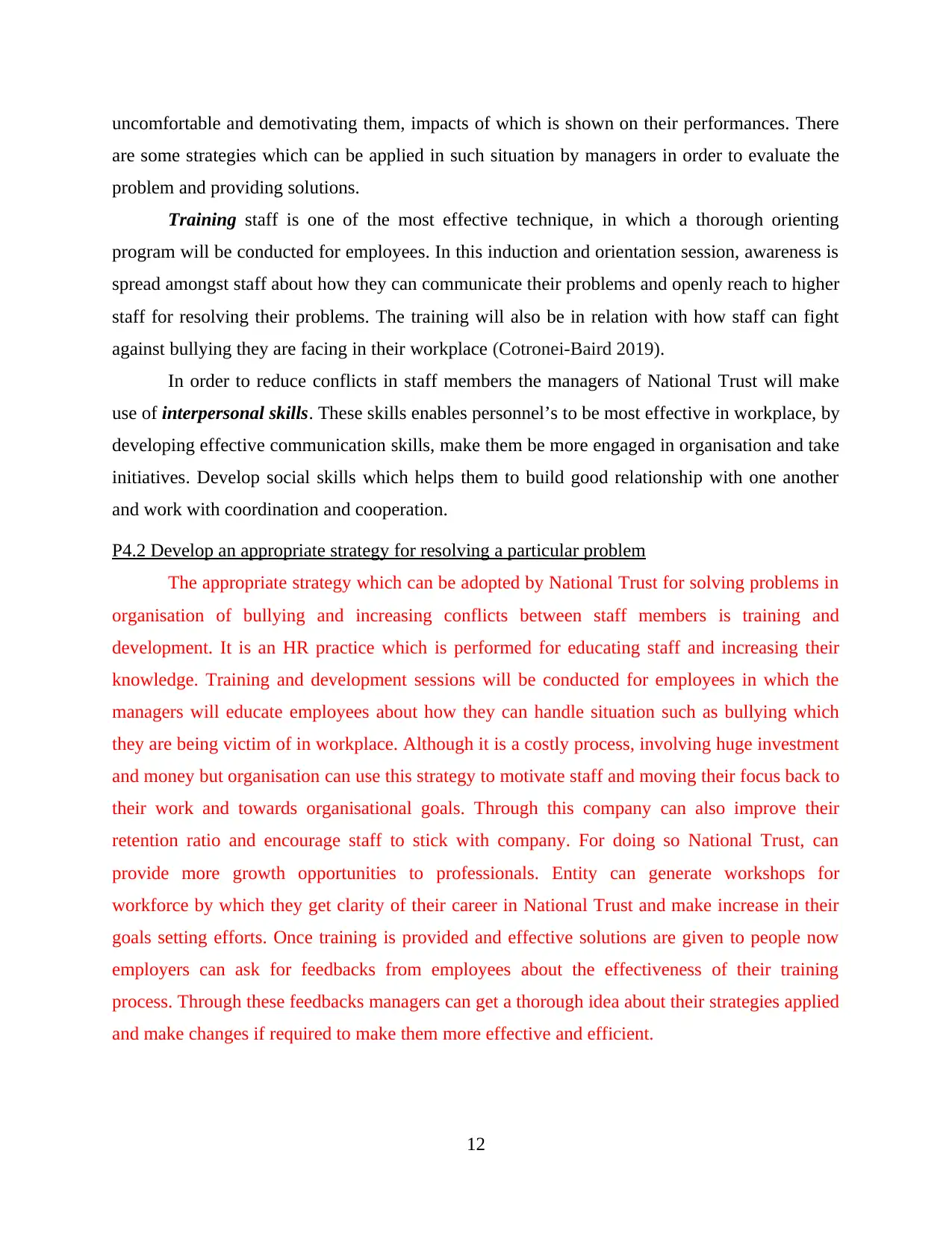
uncomfortable and demotivating them, impacts of which is shown on their performances. There
are some strategies which can be applied in such situation by managers in order to evaluate the
problem and providing solutions.
Training staff is one of the most effective technique, in which a thorough orienting
program will be conducted for employees. In this induction and orientation session, awareness is
spread amongst staff about how they can communicate their problems and openly reach to higher
staff for resolving their problems. The training will also be in relation with how staff can fight
against bullying they are facing in their workplace (Cotronei-Baird 2019).
In order to reduce conflicts in staff members the managers of National Trust will make
use of interpersonal skills. These skills enables personnel’s to be most effective in workplace, by
developing effective communication skills, make them be more engaged in organisation and take
initiatives. Develop social skills which helps them to build good relationship with one another
and work with coordination and cooperation.
P4.2 Develop an appropriate strategy for resolving a particular problem
The appropriate strategy which can be adopted by National Trust for solving problems in
organisation of bullying and increasing conflicts between staff members is training and
development. It is an HR practice which is performed for educating staff and increasing their
knowledge. Training and development sessions will be conducted for employees in which the
managers will educate employees about how they can handle situation such as bullying which
they are being victim of in workplace. Although it is a costly process, involving huge investment
and money but organisation can use this strategy to motivate staff and moving their focus back to
their work and towards organisational goals. Through this company can also improve their
retention ratio and encourage staff to stick with company. For doing so National Trust, can
provide more growth opportunities to professionals. Entity can generate workshops for
workforce by which they get clarity of their career in National Trust and make increase in their
goals setting efforts. Once training is provided and effective solutions are given to people now
employers can ask for feedbacks from employees about the effectiveness of their training
process. Through these feedbacks managers can get a thorough idea about their strategies applied
and make changes if required to make them more effective and efficient.
12
are some strategies which can be applied in such situation by managers in order to evaluate the
problem and providing solutions.
Training staff is one of the most effective technique, in which a thorough orienting
program will be conducted for employees. In this induction and orientation session, awareness is
spread amongst staff about how they can communicate their problems and openly reach to higher
staff for resolving their problems. The training will also be in relation with how staff can fight
against bullying they are facing in their workplace (Cotronei-Baird 2019).
In order to reduce conflicts in staff members the managers of National Trust will make
use of interpersonal skills. These skills enables personnel’s to be most effective in workplace, by
developing effective communication skills, make them be more engaged in organisation and take
initiatives. Develop social skills which helps them to build good relationship with one another
and work with coordination and cooperation.
P4.2 Develop an appropriate strategy for resolving a particular problem
The appropriate strategy which can be adopted by National Trust for solving problems in
organisation of bullying and increasing conflicts between staff members is training and
development. It is an HR practice which is performed for educating staff and increasing their
knowledge. Training and development sessions will be conducted for employees in which the
managers will educate employees about how they can handle situation such as bullying which
they are being victim of in workplace. Although it is a costly process, involving huge investment
and money but organisation can use this strategy to motivate staff and moving their focus back to
their work and towards organisational goals. Through this company can also improve their
retention ratio and encourage staff to stick with company. For doing so National Trust, can
provide more growth opportunities to professionals. Entity can generate workshops for
workforce by which they get clarity of their career in National Trust and make increase in their
goals setting efforts. Once training is provided and effective solutions are given to people now
employers can ask for feedbacks from employees about the effectiveness of their training
process. Through these feedbacks managers can get a thorough idea about their strategies applied
and make changes if required to make them more effective and efficient.
12
⊘ This is a preview!⊘
Do you want full access?
Subscribe today to unlock all pages.

Trusted by 1+ million students worldwide
1 out of 16
Related Documents
Your All-in-One AI-Powered Toolkit for Academic Success.
+13062052269
info@desklib.com
Available 24*7 on WhatsApp / Email
![[object Object]](/_next/static/media/star-bottom.7253800d.svg)
Unlock your academic potential
Copyright © 2020–2025 A2Z Services. All Rights Reserved. Developed and managed by ZUCOL.

